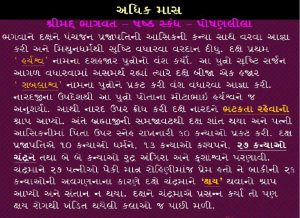Adhik Maas - 2018
So, what is an Adhik Maas (Extra Month) and what is the significance?
As you know, the Hindu calendar is based on the lunar cycle rather than the solar cycle. A lunar month is around 29.5 days long and the solar month, (calendar which we normally use) is 30 to 31 days. The lunar year consists of 354 solar days and the solar year consists of 365 days. As years pass by, each lunar month starts earlier to the corresponding solar month. There is a difference of 11 days between the lunar and solar year. As every few solar years go by, the difference between the two calendars becomes a full month or around 29 days. To compensate and get the two calendars similar, an extra month is added. Due to this difference in days, an extra month (Adhik = Extra and Maas = Month) arises after every 32 months.
Therefore, in the 2018 Hindu calendar, there is an “Adhik Maas” or an extra month. It will start on Wednesday, May 16th and end on Wednesday, June 13th. Vasishta Siddhanta, a treatise of Sage Vasishta, says that the Adhik Maas occurs after every 32 months, 16 days and 9 Ghadis. A Ghadi is 24 minutes. Needless to say, this month is very auspicious and is dedicated to Lord Krishna.
All months are dedicated to a specific Dev, and when Adhik Maas first arrived, the Devas were wondering who to dedicate it to, and it was decided that it would be dedicated to Lord Purshottam, thus it was named Purshottam Mahino, and God blessed the day by saying that whoever does bhajan bhakti during this month will please me immensely and I will burn their sins and they will attain eternal bliss.
The name Purushottam translates as “The Supreme Being” – Purush (Man), Uttam (The Greatest), and refers to Bhagawān Shree Krishna. Therefore, Shri Hari Himself has benediction over this month. In the Gita, Lord Krishna says – “Among all months, I am Myself the Purushottam month.” Observing the Purushottam ‘vrat’ is quite powerful! It is capable of washing away sins, bringing peace, harmony, good fortune and ultimate salvation.
This month is regarded as very auspicious and great Punya is attached to it, so it is very important that we do not waste this opportunity to serve Supreme Godhead Swaminarayan / Lord Krishna / Lord Purshottam Narayan, or whichever God is close to you, to the best of our ability. You will attain 1,000 times more Punya for your good deeds in this month!!
During this month, additional Religious duties are performed as prescribed in the Shikshapatri (Slokha 77-78). Satsangis also give gifts to the Lord and alms to Brahmins and the poor according to their ability. So what should be done during this opportune month? Here are just some things you might want to consider:
Daily observances include fasting, prayer, reciting Janmangal Stotra, reading Vachanāmrutam, reading Gita, dandvat, mala, focusing mind and spirit on to Bhagwan, and perform selfless actions (without any expectations), etc. We should also meditate on the overwhelming qualities of Maharaj. Maharaj Himself has said that by carrying out the vrata (vow) in this manner produces unfailing results and one overcomes the greatest of misfortunes. It is appropriate to live lightly during this time – to speak gently and with kindness, to act without anger and malice, to spread goodwill and love to all living things. It is recommended (but not mandatory) to eat grains only once a day, and only ‘sattva-goon’ foods (vegetarian meals, milk, fruits, nuts, grains, vegetables).
During the entire month and especially on the last day, one should perform ‘poon-daan’ according to one’s ability. This means performing good deeds and distributing food and/or clothing to charities, to Brahmins, and to those in need.
Don’t miss out on this opportunity that comes only once every three years. Take just 1 small tiny niyam, and do it for the whole month. Just 1 month!
Don’t forget, you reap what you sow. If you sow good seeds, they will grow into happiness! This is the season to sow good seeds of Bhajan and Bhakti.










